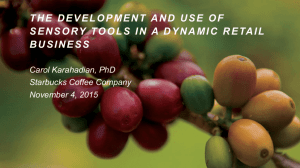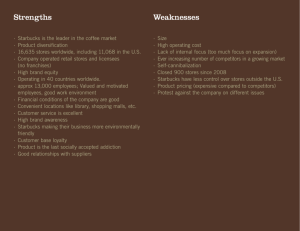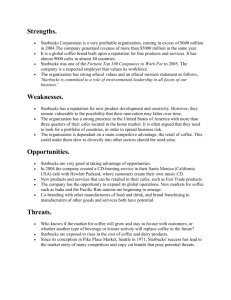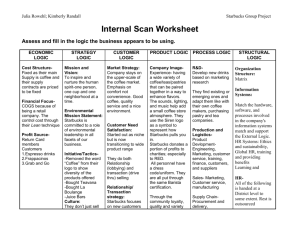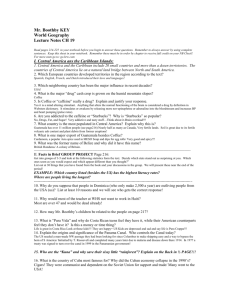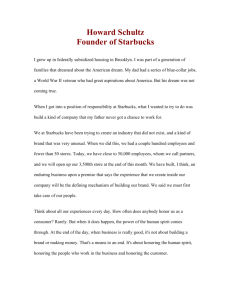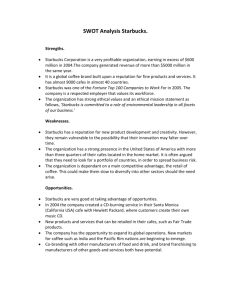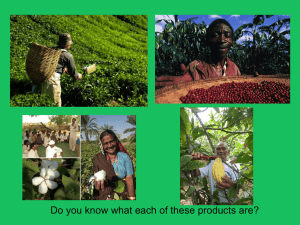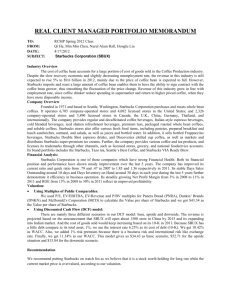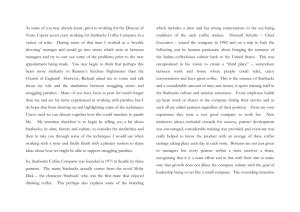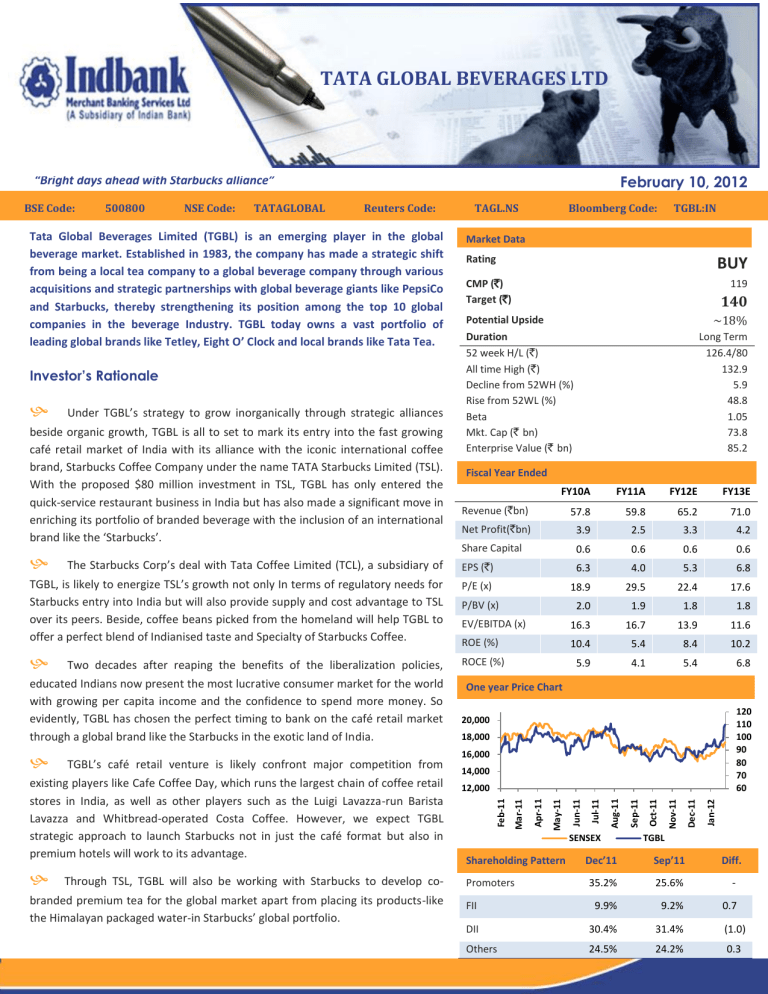
TATA GLOBAL BEVERAGES LTD
February 10, 2012
“Bright days ahead with Starbucks alliance”
BSE Code:
500800
NSE Code:
TATAGLOBAL
Reuters Code:
Tata Global Beverages Limited (TGBL) is an emerging player in the global
beverage market. Established in 1983, the company has made a strategic shift
from being a local tea company to a global beverage company through various
acquisitions and strategic partnerships with global beverage giants like PepsiCo
and Starbucks, thereby strengthening its position among the top 10 global
companies in the beverage Industry. TGBL today owns a vast portfolio of
leading global brands like Tetley, Eight O’ Clock and local brands like Tata Tea.
Investor’s Rationale
Under TGBL’s strategy to grow inorganically through strategic alliances
beside organic growth, TGBL is all to set to mark its entry into the fast growing
café retail market of India with its alliance with the iconic international coffee
brand, Starbucks Coffee Company under the name TATA Starbucks Limited (TSL).
With the proposed $80 million investment in TSL, TGBL has only entered the
quick-service restaurant business in India but has also made a significant move in
enriching its portfolio of branded beverage with the inclusion of an international
brand like the ‘Starbucks’.
TAGL.NS
Bloomberg Code:
TGBL:IN
Market Data
Rating
BUY
CMP (`)
Target (`)
119
140
~18%
Potential Upside
Duration
52 week H/L (`)
All time High (`)
Decline from 52WH (%)
Rise from 52WL (%)
Beta
Mkt. Cap (` bn)
Enterprise Value (` bn)
Long Term
126.4/80
132.9
5.9
48.8
1.05
73.8
85.2
Fiscal Year Ended
FY10A
FY11A
FY12E
FY13E
Revenue (`bn)
57.8
59.8
65.2
71.0
Net Profit(`bn)
3.9
2.5
3.3
4.2
Share Capital
0.6
0.6
0.6
0.6
EPS (`)
6.3
4.0
5.3
6.8
TGBL, is likely to energize TSL’s growth not only In terms of regulatory needs for
Starbucks entry into India but will also provide supply and cost advantage to TSL
over its peers. Beside, coffee beans picked from the homeland will help TGBL to
offer a perfect blend of Indianised taste and Specialty of Starbucks Coffee.
P/E (x)
18.9
29.5
22.4
17.6
2.0
1.9
1.8
1.8
EV/EBITDA (x)
16.3
16.7
13.9
11.6
ROE (%)
10.4
5.4
8.4
10.2
Two
ROCE (%)
5.9
4.1
5.4
6.8
Through TSL, TGBL will also be working with Starbucks to develop co-
branded premium tea for the global market apart from placing its products-like
the Himalayan packaged water-in Starbucks’ global portfolio.
16,000
14,000
SENSEX
Shareholding Pattern
Jan-12
Dec-11
Nov-11
Oct-11
Sep-11
Aug-11
12,000
Jul-11
existing players like Cafe Coffee Day, which runs the largest chain of coffee retail
stores in India, as well as other players such as the Luigi Lavazza-run Barista
Lavazza and Whitbread-operated Costa Coffee. However, we expect TGBL
strategic approach to launch Starbucks not in just the café format but also in
premium hotels will work to its advantage.
18,000
Jun-11
café retail venture is likely confront major competition from
120
110
100
90
80
70
60
20,000
May-11
TGBL’s
One year Price Chart
Apr-11
educated Indians now present the most lucrative consumer market for the world
with growing per capita income and the confidence to spend more money. So
evidently, TGBL has chosen the perfect timing to bank on the café retail market
through a global brand like the Starbucks in the exotic land of India.
Feb-11
decades after reaping the benefits of the liberalization policies,
P/BV (x)
Mar-11
The Starbucks Corp’s deal with Tata Coffee Limited (TCL), a subsidiary of
TGBL
Dec’11
Sep’11
Diff.
35.2%
25.6%
-
FII
9.9%
9.2%
0.7
DII
30.4%
31.4%
(1.0)
Others
24.5%
24.2%
0.3
Promoters
Starbucks Coffee “A Tata Alliance”, to enrich
TGBL’s branded beverage portfolio
TGBL has recently signed an equal joint venture deal with iconic
international coffee brand, Starbucks Coffee Company under the
name TATA Starbucks Limited (TSL), in line with its strategy of
growing through inorganic growth focused on strategic alliances in
addition to organic growth. Marking the entry of the Tata Group
into the quick-service restaurant business in India, especially in the
fastest growing coffee retail segment within food retail, TSL
intends to own and operate Starbucks cafés in the country, under
the brand, Starbucks Coffee “A Tata Alliance”. The alliance is
working for a speedy roll out its first Starbucks café, either Delhi or
Mumbai, the two largest cities in the country as early as AugustSeptember 2012 followed by a total of 50 cafes in the country by
the year end. The initial investment of the proposed venture is
likely to be $80 million.
Seattle based Starbucks Corporation is the largest coffeehouse
company in the world, with more than 17,000 stores in 55
countries, including over 12,500 in the United States, over 1,200 in
Canada and over 700 in the United Kingdom, 54 in Russia. The
company’s business in the Asian Pacific region accounts for only
5% of its global sales but the coffee giant’s overall revenue from
the region has seen good numbers for the December quarter, with
its aggressive expansion in South Korea, Hong Kong, Taiwan, the
Philippines, Singapore, Indonesia, Malaysia and Thailand.
Brand portfolio of TGBL
Brands
Category
Country
Tetley
Black tea, herbal tea,
fruit tea
UK and Canada
Vitax
Fruit tea
Poland
Jemca
Black tea, green tea,
herbal tea, fruit tea
Czech
Phendula
Tea
South Africa
Tata Tea
Tea
India
Coffee
USA
Coffee and tea
Russia
Good Earth
Tea
USA
Himalayan
Mineral water
India
T4 KIDZ
Hot flavored drink
UK
Laager
Tea
South Africa
Flavored water
USA
Nourishco
Non carbonated RTD
beverage
India & International
markets
Sukk
Drinkable jelly snack
UK
Eight O’Clock
Grand
Activate
On the other hand, TGBL over the years has shifted its focus from
tea plantation activities to branded beverages, to emerge as a
global beverage player through various acquisitions in many
geographical regions. The company has put immense amount of
weight behind building its brands and emphasized on maintaining
its existing ones, specially the legendary brands Tetley and Tata
Tea. Today, with leadership position in the branded tea and coffee
markets in several countries, over 90% of TGBL’s sales comes from
branded products.
The coffee shop retail’s recent partnership with the second largest
tea manufacturer of India is likely to help the former in capitalizing
on the rising coffee consumption in the world’s fastest growing
major economy after China. However, for the later, the
partnership will not only help to experience unique retail expertise
and a shared sense of business values with Starbucks Corps but
will also enrich TGBL’s strong branded beverage portfolio while
offering new beverage experiences to Indian consumers through a
leverage of the global in-home expertise of TGBL and the global
out-of-home expertise of Starbucks.
Brand-wise sales breakup FY11
Tetley
39%
Indian Tea Brands
29%
Good Earth
Jemca
12%
1%
1%
17%
1%
Eight O'Clock
Vitax
Others
TGBL- first to bank on 100 per cent FDI in single brand retail opportunity
Strict limits on foreign ownership across a wide range of industries have long kept foreign competitors at bay in India. Even if foreign
brands like Starbucks have been a catalyst for homegrown industries in India, the country hasn’t allowed them to actually open stores in
the past. Though Indian government’s most recent attempt to loosen restrictions on the likes of big global retailers like Walmart met
with popular disapproval and political outrage, Single-brand retailers like Starbucks however had an easier time after the recent
Government’s notification to raise foreign direct investment (FDI) limit single-brand retail to 100% from its prior 50%.
With the recently declared TGBL partnership with the largest coffeehouse company in the world, the owner of the Tata Tea brand has
emerged to be the first mover to capitalize on the liberalized initiative of the Indian Government in the retail space, boosting the retail
potential of Starbucks brand as the first foreign single brand retailer to enter India.
As per the provisions suggested by the Department of Industrial Policy & Promotion, for allowing FDI up to 100% in single brand product
retail trading, the proposals involving FDI beyond 51% would need to ensure mandatory sourcing of at least 30% of the value of products
sold, to be done from Indian ‘small industries/village and cottage industries, artisans and craftsmen. Starbucks early 2011 deal with Tata
Coffee ltd, a unit of TGBL, to source and roast premium coffee beans from India completely meets the above regulatory requirements
and hence will also work to the advantage of TGBL.
TGBL to reap cost benefit from Tata CoffeeStarbuck partnership
TCL, a coffee subsidiary of TGBL is likely to materialize it’s an year
old discussion with Starbucks Corp. to supply premium coffee
beans, as the later paces up for its much-awaited entry into India.
As per the arrangement between the duo, TCL, the owner of the
US based Eight O' Clock Coffee Co, will be roasting coffee
produced in the company’s estates using Starbucks know-how and
technology and packaging, sale and distribution thereof to
Starbucks Cafes to be set up by TGBL as well as Starbucks Corp’s
business operations in the overseas markets.
TGBL’s product-wise revenue contribution in FY11
65%
33%
TCL is arguably the largest integrated coffee plantation company
in the world. The company has a hand in every aspect of the
coffee making process, with business activities ranging from
growing and curing of coffee and tea to the manufacture and
marketing of value-added coffee products. The alliance between
TCL and Starbucks is likely to pave the way for consumers in India
to enjoy the premium Starbucks Experience, while further
discovering the unique taste of high quality Indian Arabica coffee
worldwide.
2%
Tea
Coffee
Plantation & Others
TGBL derives 70% of its consolidated revenue from the overseas market with a contribution of 33% from TCL, whose overseas unit Eight
O' Clock Coffee Co. has a firm grip in the US market. The TCL- Starbucks Corps’ will help TGBL to enhance its revenue realization from
the coffee segment in the domestic terrain. Beside, the Starbucks Corp’s deal with TCL to source coffee bean from the homeland will
help TSL to avoid the 100 percent duty that Coffee Bean, Gloria Jeans Coffee and Costa have to pay and hence provide a supply and cost
advantage over its peers. Coffee costs account for 40-45% of total operating cost of the café retails chains of India. Hence we expect
TCL-Starbucks deal to give TSL a better pricing edge in the Indian market.
Right opportune time for TGBL for Starbucks Venture
Two decades after reaping the benefits of the liberalization policies, educated Indians now present the most lucrative consumer market
for the world with growing per capita income and the confidence to spend more money. So evidently, there could have been no other
opportune time for TGBL to bring the Starbucks Coffee brand in the exotic land of India.
TGBL’s proposal to open its first Starbucks outlet in the most populated cosmopolitan business city, Mumbai or the nation’s capital,
New Delhi has been strategically picked to ensure success of the business venture and will serve as test locations for the future
expansion purpose of the venture.
If the proposed 50 stores are highly profitable in the first year, TGBL may raise the count of its Starbucks café up-to 3000 in India. TGBL
intends to customize their menu to meet the tastes of their new target market. This includes the addition of more tea items taking in
accordance that Indians are known to be more a “tea-drinking” population, as well as adding some new flavors in their coffee selection.
TGBL to attract consumers with Indian spices
sprinkled over Starbucks recipes at premium prices
TSL’s competition against present Indianised menu of peers
TGBL’s introduction of the legendary Starbucks experience,
something the global café retailer is known for in the 57 markets
across the world, in a highly tea drinking nation, is built on a
strategic approach. Though TGBL-Starbucks venture proposes to
offer some of Starbucks core products of espresso-based drinks
like “frappuccino” and the “latte,” in its menu, it will also focus on
differentiating itself from competition. Starting with the quality of
products that it intends to serve, Starbucks intends to offer unique
beverage experiences to Indian consumers through a blend of
Indo-American taste. Besides, the sourcing of coffee beans from
the homeland will help TSL to roll out the Indianised taste of
coffee. The company is also in agreement with TajSATS to develop
food products that matched the local taste and preference of the
consumers across its Indian outlets.
Peer
A list of its Specialty beverages that Starbucks offers to its
customers in other markets is also likely to be tested in the Indian
sub-continent. Additionally, Starbucks packaged coffees and other
products as well as famous loyalty programmes, which have been
huge hits in emerging markets like China, are also on TSL’s cards.
TGBL along with Starbucks is also working to develop co-branded
premium tea. Apart from this, the alliance presents an opportunity
to TGBL to place its products-like the Himalayan packaged water-in
Starbucks’ global portfolio.
The Proposed items in the Starbucks-“ A Tata Alliance” menu are
likely to be priced at a premium level, in line with Starbucks Pricing
policy in China. We expect, Starbucks to charge around `125-150
for a cup of coffee and an average price of food items to be set at
`80 in India.
Barista
Lavazza
Indianised Menu
Level of
Customization
Chai Latte
40-45%
Caffe Chai Latte
Spicy Creamy Chicken Sandwich
Chicken Tikka Sandwich/Wrap/Pizza
Chicken Masala Wrap
Chicken Korma
Paneer Korma
CCD
Spicy Chicken Calzone
30%
Veg Samosa
Paneer Tikka Sandwich
Murg Chole Sandwich
Costa Coffee
Paneer Tikka Sandwich
10%
Tomato & Cucumber Sandwich
Chicken Tikka Sandwich
Coffe Beans
& Tea Leaf
Masala Paneer Cosanta
Masala Double Decker Sandwich
10%
TGBL’s Starbuck coffee targets wide consumer
group
The Primary target market for TSL in India is the young both male
and female from the ages of 16-38. This market is well educated
and comes from middle class to upper middle class population.
India, long a country of tea drinkers, has experienced an explosion
in cafes and restaurants over the last decade because of its
growing middle class and a large youth population
The two new proposed locations for Starbucks Coffee shops are
strategically picked to ensure their success. Both Mumbai and
New Delhi are home to many call centers where these younger
spenders work, and many colleges and Universities are also
located here. This will allow Starbucks to target the younger
consumer generation with the advertisement campaign. These
two cities are also major hot spots for tourists, who recognize a
multinational brand such as Starbucks. The new Starbucks menu
must cater to the India taste, mixing traditional menu items with
those that a customized for the Indian tastes.
Footfall Comparison-Upcoming TSL V/S Existing Peers
Company
Average customer
footfall per outlet per
day
No of outlets
CCD
450
1230
Barista Lavazza
400
230
Costa Coffee
175
75
TSL (Proposed)
250
50
The secondary target markets for TGBL’ Starbucks coffee is the tourists in the areas. Tourists will recognize Starbucks, as it is a
multinational company, as most tourists in India come from the countries of U.S., England, Germany, and Japan. This market will also
fall in the middle to upper middle class population and will find the TSL prices relatively cheap.
To have a better edge over the regional peers, TSL would not only sell premium coffee, tea and food in its Indian stores in its café
format but also in Premium hotel chains, in partnership across carious cities. In fact, some of the Taj properties belonging to Indian
Hotels would be roped in to sell products and food services belonging to Starbucks.
TGBL to get brand royalty benefit
As per the legal arrangement of the mega alliance between two multi-billion-dollar brands, the JV will have to adhere to Tata Group's
brand code and licence fee rules and pay royalty.
In the mid-1990s, Tata Sons, the closely held holding company for the group, had announced a royalty —or a “contribution” or a “fee”
— to be charged from all Tata group companies for the use of the Tata name, either directly in the company’s name or indirectly. The
fee ranged from 0.25% of the turnover (not exceeding 5% of net profit) from blue-chip group companies to 0.10%, depending on the
brand leverage. Joint ventures where the foreign partner was offering its brand name gratis were exempted. Tatas are possibly the
only Indian corporate house to have institutionalized a brand code of conduct and have a separate cell within Tata Sons called Brand
Equity and Brand Promotion Fund to monitor all brand-related issues.
In 2011, according to the world’s leading brand valuation consultancy firm Brand Finance, the diversified Tata Group corporate brand
was valued a little over $15 billion. It was the only Indian conglomerate to have broken into the top 50 global brands in the elite Brand
Finance 500. In the same year, Starbucks was ranked 184th, with a valuation of $5.4 billion. This is perhaps the first time an Indian
corporate has been able to command a value or a licence fee for an intangible asset like a brand. So, it’s an alliance of equals and
Starbucks in India will not be an overriding foreign brand.
TSL to receive inspiration from Chinese success
rate of Starbucks
Though the global coffee café retailer is expected to struggle in
grabbing hot beverage market in the traditionally tea-drinking
country, the TSL is confident that the brand value of Starbucks
will see an overwhelming response in the India, especially after
its success in China, a country much like India with its fastgrowing economy and over a billion people. Under its strategic
growth approach in China, Starbucks played into the growing
Chinese middle class's love of American brands and conspicuous
consumption at a premium pricing. Though Starbucks has
emerged as a great success in China with 500 stores in mainland
China by December 2011 and splendid revenue growth of ~40%
in the region, TSL might confront some difficulty in playing with
an exact replicated strategy in India. Though the two countries
share many similarities, like a large population, rapid growth, and
a history as a tea culture, India's per capita net income is less
than half of China's.
Indian economy V/S Chinese economy
Parameters
China
India
Population
1,341 million
1210 million
GDP
$5,879 billion
$1729 billion
8.9%
6.9%
$2,425.47
$822.76
Inflation Rate
4.50%
6.49
Interest Rate
6.56%
7.50
Industrial Production
12.80%
5.90%
GDP Growth rate
Per Capita GDP
However, with TSL emphasis on growing a business model to cater the local consumer wants of premium specialty drinks in India,
instead of trying to force onto the market the same products that worked in the US like regular coffee, we expect, TSL to garner the
favoritism of Indian coffee drinkers at a faster pace. Beside, the growing young population has always proved keen on owing anything
with an international brand, starting from apparels to food habits, which has made India a very lucrative destination for the
International retailers. Given the success of other American food chains in India, the exploding coffee market, and the company's track
record in China, Starbucks' venture with Tata looks to be the next in line of winning growth opportunities for the coffee kings. Beside,
Indian youth, with growing per capita income and desire to have a taste of an international brand like the Starbucks will be willing to
pay a premium to visit the hip, new coffeehouses instead of older, cheaper ones that their parents' generation prefers.
Indian’s growing taste for coffee opens a wider market for TGBL
Starbucks’ arrival in India may put the country’s coffee market on the map, but Indian’s growing taste for coffee has been years in the
making. In coffee-producing southern India, coffee has long trumped tea as the drink of choice, but the industry has thrived on
exports, rather than cultivating and deepening local consumption. Over the past decade, coffee consumption in the country has almost
doubled. Coffee chains have sprouted nationwide from urban centers to highway rest stops. One thousand of them have opened in
just the past 5 years — a number expected to grow five times over the next several years — catering to a coffee-drinking market that is
growing by 25% each year.
The growth of coffee houses, as well as coffee consumption in India, however, hasn’t always been about the coffee itself, if at all. In a
country known for its tea drinking, the coffee itch has taken hold among India’s youth, and Café Coffee growth from several dozen
cafés in India’s biggest metropolis, to over 1,200 outlets in 175 cities stands in testimony to it. The growth has also lured other foreign
coffee brands, such as Italy’s Lavazza, which opened Barista cafés, and the California-based Coffee Bean & Tea Leaf.
India’s growing economy and its billion-plus population means there’s plenty of room for Starbucks. Even if TSL were to target the top
20% of this population, it will be looking at a population which is potentially the same size as the entire US. In long run, we see no
reason why India, like China, would not be able to support 3,000 Starbucks stores down the line.
Stiff Competition ahead
Though the much awaited dream of Starbucks to enter the
untrapped market of India has come to reality with the TSL venture,
the global retailer might have to ride on a rough road, especially in
a traditionally tea drinking nation. Overall annual coffee
consumption of about 85 grams per capita in India also stays far
below the 4.1 kilograms of consumption in the United States or
even the 3.6 kilograms in Japan. However, Indians have lately been
taking to ordering espressos and cappuccino at quick-service cafes
as a growing young population are increasingly adapting to
Western tastes. Domestic consumption of coffee also rose to an
estimated 108,000 tonnes (119,000 tons) in 2010, up 80% in the
past decade. Hence Starbucks as an international brand can be said
to have entered the subcontinent at the right time to change the
patent taste of the India.
TGBL Starbucks Coffee is also expected confront major competition
from existing face competition from Cafe Coffee Day -- a unit of
Amalgamated Bean Coffee Trading -- which runs the largest chain
of coffee retail stores in India. Other players such as the Luigi
Lavazza-run Barista Lavazza chain of espresso bars and Whitbreadoperated Costa Coffee stores have a head-start over Starbucks as
well. Leading coffee chains like Café Coffee Day and Costa Coffee
have already registering double−digit growth rates and have
maximum footfalls in the organized sector. However, the
international popularity of the Starbucks brand along with superb
marketing strategies and assurance of quality is likely to favor TSL in
establishing brand loyalty among Indian consumers.
TSL V/s Peers-Competitive Edge
CCD
Barista
Lavazza
Costa Coffee
TSL
(proposed)
•1230 stores across India
•Estimated Revenue in 2011 is $118 mn
•Wide presence and easy availabilty
•Good Value for money
•230 stores across India
•Estimated Revenue in 2011 is $45 mn
•Classy and good ambience
•Elaborate food and brevarage menu
•73stores across India
•Estimated Revenue in 2011 is $18 mn
•Premium market positioning
•Popular among working prefessionals
•Variety of Coffee & tea blends
•Customised brevages and food for the Indian Pallette
•50 cafes by year end with exotic cafe Enviroment
•International Brand Value
•Cost Advantage over the TCL-Starbucks deal
Challenges
Stiff Competition: Domestic chains like Cafe Coffee Day and Barista are big hits as the value-for-money youth hangout. Global brands
have already made their mark among the Coffee loving crowd.
Location: Suitable locations are hard to come by - news is Starbucks is driving hard bargains for swishy addresses at cheaper prices.
Premium cafes are unique in India. Hence the expectations of target customers from the café environment are likely to be very high. So
such coffee shops have to be more visible and located in high streets and premium malls with exorbitant rentals.
Customization: Starbucks is known to have integrated local colours with its signature style. But to attract the Indian coffee drinkers, the
brand may have to churn out specialities suited to Indian tastes.
Strategic Approach: TSL sees Starbucks to operate a replicated business model used in China but though with similar population, the per
capita income and ability to spend of an average individual between China and India has vast differences.
Cost for one year of Operation of TSL
Expected Revenue from TSL
Amount (` million)
Cost heads
Natural Resources: coffee beans,
tea, spices, etc.
Land: store rental, utilities costs
Labor: approximately 50
Employees (including employees
ex. Managers, marketing
Specialists, human resource etc.)
Marketing- billboard and print
Advertising. Costs listed in
previous sections.
200
204
We expect TSL to clock in revenue of around `927 million
under a very conservative approach by the end of 2012.
With operating expenses ranging at ~`630 million, which is
around 68% of the total revenue realized, the operating
income would be pulled down to `296 million. After
reducing a taxation of ~`97 million, we see TSL striking a
profit of `198 million by year end. Considering an equal
distribution of revenue under the joint venture agreement
between TGBL and Starbucks Corps, we expect TGBL to
receive ~`99 million profits from TSL venture.
Assumptions
96
50
60
Licensing and Legal Work- USD
10,000
20
Miscellaneous Costs- repairs,
emergency costs
TSL achieves its targeted 50 outlets by the end of 2012
in India
Each outlet receives an average per day footfall of 250
coffee consumers
An average customers makes an average pay of `125
per coffee and `80 for food item
TSl closes its stores for only 3 days in the year for
Diwali (Indian holiday) and Christmas.
Higher store set up cost to weigh on first year
operating income
33% taxation is paid on total operating income
Rent to revenue ratio of a premium cafe kept ideally at
around 15%
630
Total
TGBL vs. local peer’s relative valuation
Company
Mcap (billion)
EPS
P/E (x)
P/BV
EV/EBITDA
ITC
1,527
6.5
31.0
9.5
20.6
HUL
864
10.5
36.9
31.0
29.9
Nestlé
399
84.9
50.5
48.3
28.0
Marico
85
4.6
34.7
10.9
23.8
TGBL
74
4.0
29.5
1.9
16.7
Britannia
52
11.2
43.9
18
27.4
Balance Sheet (Consolidated)
(`billion)
Profit & Loss Account (Consolidated)
FY10A
FY11A
FY12E
FY13E
(`billion)
FY10A
FY11A
FY12E
FY13E
0.6
0.6
0.6
0.6
Net Sales
57.8
59.8
65.2
71.0
Reserves& Surplus
36.6
38.9
39.7
41.5
Total Expenses
52.6
54.6
59.1
63.9
Shareholders’ Funds
37.2
39.5
40.3
42.1
EBITDA
5.1
5.1
6.0
7.2
Minority Interest
10.5
11.0
11.0
11.0
EBITDA Margin %
8.8
8.5
9.2
10.1
Total Loans
17.9
10.4
9.4
8.4
Depreciation
1.0
0.9
1.1
1.2
0.7
0.6
0.6
0.6
EBIT
4.1
4.1
5
6
Capital Employed
66.5
61.7
61.5
62.2
Interest
1.5
1.2
1.2
0.9
Gross fixed assets
14.7
15.6
17.0
18.5
Other Income
3.8
2.0
1.9
1.9
Less: acc. depreciation
7.5
8.4
9.5
10.7
Profit Before Tax
6.4
4.9
5.6
6.9
Net Block
7.1
7.2
7.5
7.8
Tax
2.5
2.0
1.8
2.3
Capital WIP
0.5
0.4
0.4
0.4
Profit After Tax
3.9
2.9
3.8
4.6
29.2
30.3
30.3
30.3
Minority Interest
0.3
0.6
0.6
0.6
5.1
5.8
6.1
6.2
Adj. Net Profit
3.9
2.5
3.3
4.2
Net Current Assets
24.3
17.8
17.0
17.3
Capital Deployed
66.5
61.7
61.5
62.2
Equity Share Capital
Deferred Tax Liability
Goodwill
Investment
Valuation & Views
Key Ratios
FY10A
FY11A
FY12E
FY13E
EBITDA Margin (%)
8.8
8.5
9.2
10.1
EBIT Margin (%)
7.1
6.9
7.7
8.5
NPM (%)
6.7
4.2
5.1
5.9
ROCE (%)
5.9
4.1
5.4
6.8
ROE (%)
10.4
5.4
8.4
10.2
EPS (`)
6.3
4.0
5.3
6.8
P/E (x)
18.9
29.5
22.4
17.6
BVPS
59.6
63.4
64.6
67.4
P/BVPS (x)
2.0
1.9
1.8
1.8
EV/Operating Income (x)
1.4
1.4
1.3
1.2
EV/EBITDA (x)
16.3
16.7
13.9
11.6
EV/EBIT (x)
20.3
20.8
16.7
13.9
TGBL has a very ambitious plan to generate revenue of US$5bn
by 2015, which has recently reflected some sluggishness due to
the slow growth in its key categories (tea and coffee) as well as
slowdown due to the ongoing global as well as local
macroeconomic scenario. TGBL has a long term strategy to
bank on the fast growing consumer market of India. We expect
the recent TGBL and Starbuck alliance to emerge as a prime
revenue driver for TGBL in long run, by enhancing its portfolio
of branded beverages and intensifying growth in its coffee
segment. At a current CMP of `119, TGBL is attractively placed
at P/E of ~17.6.x FY13E. Considering the above aspects, we rate
the stock as ‘BUY’ with a potential upside of 18% for the
coming 12 months.
Indbank Merchant Banking Services Ltd.
I Floor, Khiviraj Complex I,
No.480, Anna Salai, Nandanam, Chennai 600035
Telephone No: 044 – 24313094 - 97
Fax No: 044 – 24313093
www.indbankonline.com
Disclaimer
@ All Rights Reserved
This report and Information contained in this report is solely for information purpose and may not be used as an offer document or solicitation
of offer to buy or sell or subscribe for securities or other financial instruments. The investment as mentioned and opinions expressed in this
report may not be suitable for all investors. In rendering this information, we assumed and relied upon, without independent verification, the
accuracy and completeness of all information that was publicly available to us. The information has been obtained from the sources that we
believe to be reliable as to the accuracy or completeness. While every effort is made to ensure the accuracy and completeness of information
contained, Indbank Limited and its affiliates take no guarantee and assume no liability for any errors or omissions of the information. This
information is given in good faith and we make no representations or warranties, express or implied as to the accuracy or completeness of the
information. No one can use the information as the basis for any claim, demand or cause of action.
Indbank and its affiliates shall not be liable for any direct or indirect losses or damage of any kind arising from the use thereof. Opinion
expressed is our current opinion as of the date appearing in this report only and are subject to change without any notice.
Recipients of this report must make their own investment decisions, based on their own investment objectives, financial positions and needs of
the specific recipient. The recipient should independently evaluate the investment risks and should make such investigations as it deems
necessary to arrive at an independent evaluation of an investment in the securities of companies referred to in this document and should
consult their advisors to determine the merits and risks of such investment.
The report and information contained herein is strictly confidential and meant solely for the selected recipient and is not meant for public
distribution. This document should not be altered in any way, transmitted to, copied or distributed, in part or in whole, to any other person or
to the media or reproduced, duplicated or sold in any form.

